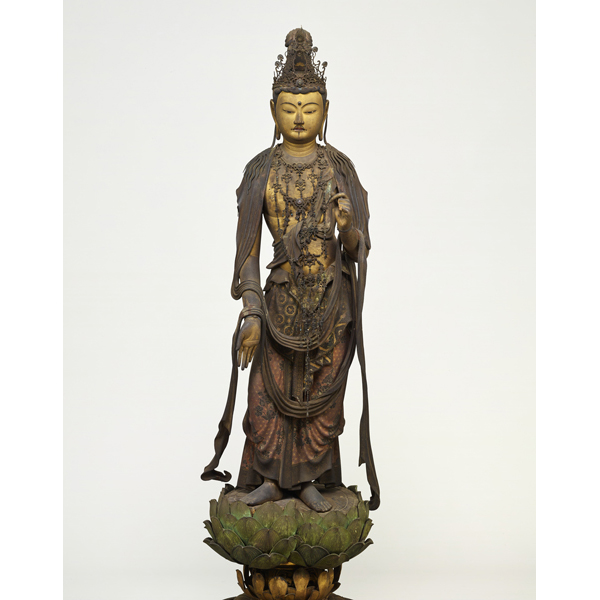彫刻
-

重要文化財 菩薩立像
鎌倉時代・13世紀本館 11室
2022年8月30日(火) ~ 2022年12月25日(日)江戸時代までの日本の彫刻は、寺院や神社に安置された仏像、神像、肖像で占められています。明治時代以降、寺院や神社から離れた彫刻を美術館や博物館が収蔵するようになり、その代表が国の博物館でした。この部屋では、当館の150周年を記念して、館蔵彫刻の名品を展示し、日本彫刻の魅力をご覧いただくとともに、収蔵の歴史を紹介します。
| 指定 | 名称 | 員数 | 作者・出土・伝来 | 時代・年代世紀 | 所蔵者・寄贈者・列品番号 | 備考 | |
| おすすめ | 重文 | 菩薩立像 | 1躯 | 鎌倉時代・13世紀 | C-20 | 創立150年記念特集「未来の国宝―東京国立博物館 彫刻、工芸、考古の逸品―」 | |
| 如来立像 | 1躯 | 京都・泉涌寺伝来 | 鎌倉時代・13世紀 | C-21 | |||
| 重文 | 阿弥陀如来および両脇侍立像(善光寺式) | 3躯 | 鎌倉時代・建長6年(1254) | C-93 | |||
| 重文 | 十一面観音菩薩立像 | 1躯 | 中国 奈良・多武峯伝来 | 唐時代・7世紀 | C-304 | ||
| 文殊菩薩立像 | 1躯 | 鎌倉時代・13世紀 | C-23 | ~2022年11月27日 | |||
| 如意輪観音菩薩坐像 | 1躯 | 鎌倉時代・13世紀 | C-1883 | 2022年11月29日~ | |||
| 吉祥天立像 | 1躯 | 京都府亀岡市・大宮神社伝来 | 平安時代・10世紀 | C-1833 | |||
| 重文 | 十二神将立像(辰神) | 1躯 | 京都・浄瑠璃寺伝来 | 鎌倉時代・13世紀 | C-15 | ||
| 重文 | 十二神将立像(巳神) | 1躯 | 京都・浄瑠璃寺伝来 | 鎌倉時代・13世紀 | C-1852 | ||
| 重文 | 十二神将立像(未神) | 1躯 | 京都・浄瑠璃寺伝来 | 鎌倉時代・13世紀 | C-16 | ||
| 重文 | 十二神将立像(申神) | 1躯 | 京都・浄瑠璃寺伝来 | 鎌倉時代・13世紀 | C-1878 | ||
| 重文 | 十二神将立像(戌神) | 1躯 | 京都・浄瑠璃寺伝来 | 鎌倉時代・13世紀 | C-1853 | ||
| 重文 | 愛染明王坐像 | 1躯 | 鎌倉時代・13世紀 | C-1858 | |||
| 地蔵菩薩立像 | 1躯 | 鎌倉時代・13世紀 | C-332 | ||||
| おすすめ | 重文 | 大日如来坐像 | 1躯 | 平安時代・11~12世紀 | C-311 | ||
| おすすめ | 重文 | 不動明王立像 | 1躯 | 平安時代・11世紀 | C-1525 | ||
| おすすめ | 重文 | 文殊菩薩騎獅像および侍者立像 | 5躯 | 康円作 奈良・興福寺伝来 | 鎌倉時代・文永10年(1273) | C-1854 |
